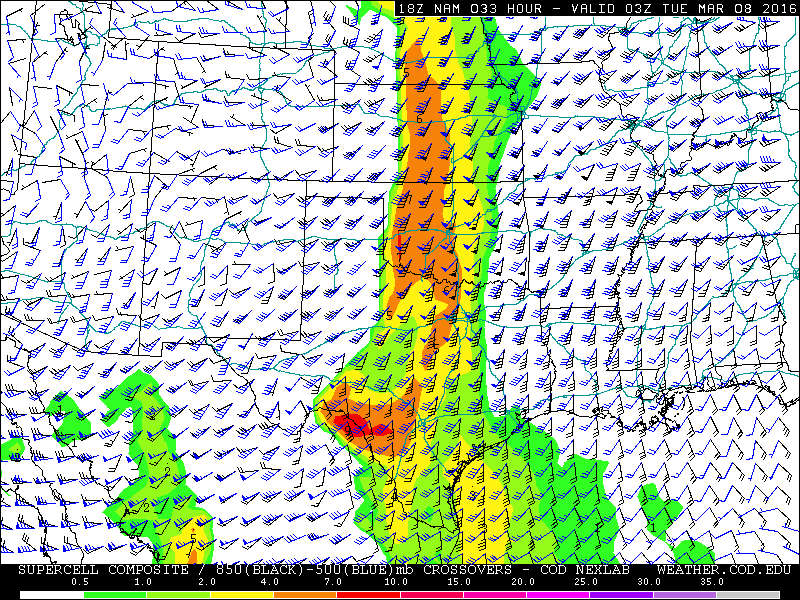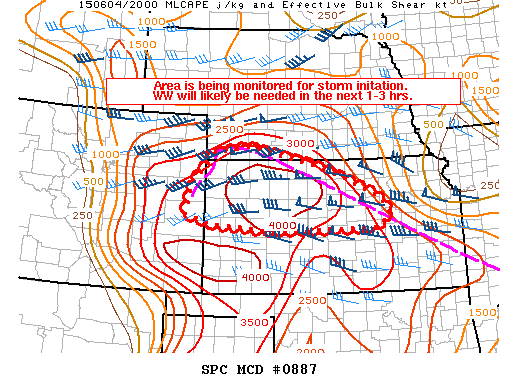What is the Supercell Composite Parameter?
Multiple variables are important to consider when it comes to supercell thunderstorm development. The Supercell Composite Parameter (SCP) was created to factor three important ingredients to determine how favorable an environment is to produce supercells. SCP focuses on instability, wind shear and helicity (potential for updraft rotation). SCP is a parameter that starts at zero and becomes higher as there is better overlap of parameters to favor the formation of supercells. For example, an SCP of zero suggests that supercells are unlikely to form, while a value of 10 suggests a much better likelihood of supercell formation. There will be more discussion later on as to what SCP values support supercells.
Calculating SCP
MUCAPE term * effective bulk shear term * effective SRH term
instability term * wind shear term * helicity term
The equation is more specifically
(MUCAPE/1000 J•kg-1) * (EBWD/20 m•s-1) * (ESRH/50 m2s-2)
This tells us that each variable has a “threshold” in the equation. Basically, instability of 1000 J•kg-1 will equal out to 1. For bulk shear, 20 m•s-1 (~39 knots) will bring that term to 1. With helicity, 50 m2s-2 is the threshold. (EBWD stands for effective bulk wind difference/shear) Effective shear is used instead of 0-6km shear, for example, since it takes into account storm depth. Effective SRH is used as opposed to standard SRH, as ESRH is tuned to discriminate against environments with considerable capping, that may prevent air from being able to rise and form a thunderstorm.
An SCP value of 1 is relatively low and most surface-based supercells form when SCP is between 2 and 11. Values much higher are relatively uncommon, but when they do happen, there is a strong probability of supercell formation, assuming other ingredients come into play, such as forcing, breaching a cap and storm mode. The average value for SCP with supercells ends up being close to 6.
There are some other considerations to make. Elevated supercells can and often form with "low" SCP values. In fact, some can form with an SCP value below 1 and the average value for elevated supercells is only about 2. An elevated supercell will form in an environment where there is elevated instability, but there may be a low-level inversion that prevents the supercell from routing itself at the surface. Likewise, marginal supercell structures that may be messy or disorganized, can also form with low SCP values.
Also, an SCP value can be extremely high, such as 20+, but if there is no forcing mechanism to trigger thunderstorm initiation, there could easily be no supercells in such an environment. This seems to be most common on hot, summer days where there is extreme instability in place, but only modest wind shear/helicity.
Below is an example from 2015 where SCP values were over 30 across parts of Kansas, largely due to extreme instability. However, a lack of forcing delayed supercell initiation for several hours.
The parameter is also helpful because it will be set to a lower value if, for example, there is considerable instability, but little to no wind shear. As wind shear drops below the ~39 knot threshold, the term falls closer to 0, setting the entire equation to a lower resultant number.
In summary, SCP is a helpful parameter to evaluate the favorability for supercell thunderstorm development. It takes into account instability, wind shear and helicity, outputting a larger value where there is the best overlap of supportive ingredients. For surface-based supercells, SCP is generally higher than 1. SCP should always be used in combination with other considerations, as a favorable SCP value may not yield any supercells, if there is nothing to trigger updraft (thunderstorm) formation.
Read more here: http://www.spc.noaa.gov/publications/thompson/stp_scp.pdf
Forecast models that show SCP: http://weather.cod.edu/forecast/





0 Comments
Recommended Comments
There are no comments to display.
Create an account or sign in to comment
You need to be a member in order to leave a comment
Create an account
Sign up for a new account in our community. It's easy!
Register a new accountSign in
Already have an account? Sign in here.
Sign In Now